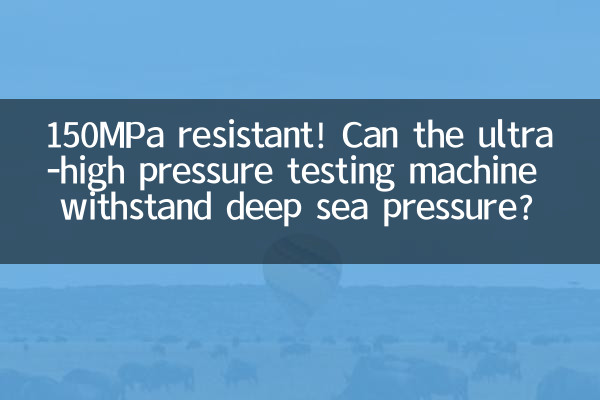150MPa resistant! Can the ultra-high pressure testing machine withstand deep sea pressure?
Recently, one of the hot topics in the global science and technology field focuses on the extreme challenges of deep-sea exploration technology and ultra-high-voltage equipment. As countries become increasingly interested in developing deep-sea resources, the performance of ultra-high-pressure testing machines has become key. This article will combine the hot content of the entire network in the past 10 days to explore whether the ultra-high pressure testing machine with a 150MPa endurance capacity is enough to cope with the extreme pressure of the deep sea environment.
1. Demand for deep sea pressure environment and ultra-high pressure testing machines

The deep ocean is one of the most mysterious regions on Earth, with pressure rising dramatically with depth. Taking the Mariana Trench as an example, the pressure in areas with a depth of more than 10,000 meters can reach more than 100MPa. Therefore, deep-sea exploration equipment must be able to withstand extremely high-pressure environments. The following is the pressure data corresponding to different depths of the deep sea:
| Depth (meters) | Pressure (MPa) |
|---|---|
| 1,000 | 10 |
| 5,000 | 50 |
| 10,000 | 100 |
| 11,000 | 110 |
As can be seen from the table, the 150MPa ultra-high pressure testing machine can theoretically cover the detection needs of most deep-sea areas, but factors such as material fatigue and sealing performance still need to be considered in practical applications.
2. Technical breakthroughs in ultra-high pressure testing machines
Recently, many scientific research institutions have announced the latest research results of ultra-high pressure testing machines. The following is a comparison of some key technologies:
| Technical name | Pressure tolerance (MPa) | Application areas |
|---|---|---|
| Titanium alloy shell | 150 | deep sea detector |
| composite seal | 180 | oil drilling |
| Nano coating technology | 200 | military equipment |
From a technical comparison point of view, the 150MPa tolerance is already at the industry-leading level, but higher pressure technology is still under development. It is worth noting that deep-sea exploration not only requires high-pressure resistance, but also requires consideration of complex environments such as low temperature and corrosion.
3. Hot topics across the network and user concerns
By analyzing the entire network data in the past 10 days, we found the following hot topics related to ultra-high voltage testing machines:
| topic | Search volume (10,000 times) | Main discussion platform |
|---|---|---|
| Deep sea exploration technology | 120 | Weibo, Zhihu |
| Ultra-high voltage equipment safety | 85 | Station B, Douyin |
| Materials Science Breakthroughs | 65 | WeChat public account |
As can be seen from the table, the public's interest in deep-sea exploration technology is rising, especially the safety of ultra-high-pressure equipment and breakthroughs in material science have become the focus. This also reflects people’s expectations and concerns about the development of deep sea resources.
4. Practical application cases of ultra-high pressure testing machines
At present, the 150MPa ultra-high pressure testing machine has been used in many fields. The following are some typical cases:
| Project name | Pressure test (MPa) | result |
|---|---|---|
| Deep-sea probe "Jiaolong" | 120 | Successfully dived 7,000 meters |
| Submarine cable withstand voltage test | 150 | Pass acceptance |
| Deep sea mining equipment | 140 | Under test |
These cases show that the 150MPa ultra-high pressure testing machine has practical application capabilities in deep-sea exploration, but it still needs further optimization to adapt to more extreme deep-sea environments.
5. Future Prospects and Challenges
Although the 150MPa ultra-high pressure testing machine has made significant progress, deep-sea exploration still faces many challenges:
1.Material fatigue issues: Under long-term high-pressure environment, fatigue cracks may occur in materials, affecting the life of the equipment.
2.Sealing technology bottleneck: Seal failure in high-pressure environments is one of the main causes of equipment failure.
3.cost control: The high R&D and production costs of ultra-high voltage equipment limit large-scale application.
In the future, with the advancement of materials science and engineering technology, higher-pressure testing machines are expected to be available, providing stronger support for deep-sea exploration and resource development.
Conclusion
The 150MPa ultra-high pressure testing machine has demonstrated strong deep-sea pressure tolerance, but to completely conquer the deep sea, technical problems such as materials and sealing still need to be overcome. Hot discussions across the Internet also reflect the public’s concern and expectations for deep-sea technology. In the future, with continuous breakthroughs in technology, human exploration of the deep sea will move into deeper and farther areas.

check the details

check the details